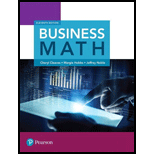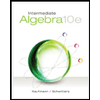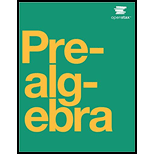
Business Math (11th Edition)
11th Edition
ISBN: 9780134496436
Author: Cheryl Cleaves, Margie Hobbs, Jeffrey Noble
Publisher: PEARSON
expand_more
expand_more
format_list_bulleted
Concept explainers
Question
Chapter 1, Problem 8CT
To determine
The operations that has to used to calculate the missing part if the total amount and all the parts except one is known.
Expert Solution & Answer
Want to see the full answer?
Check out a sample textbook solution
Students have asked these similar questions
Can you tell the answer
ce-
216
Answer the following, using the figures and
tables from the age versus bone loss data in
2010 Questions 2 and 12:
a. For what ages is it reasonable to use the
regression line to predict bone loss?
b. Interpret the slope in the context of this
wolf X
problem.
y
min ball bas
oft
c. Using the data from the study, can you
say that age causes bone loss?
srls to sqota bri
vo X 1931s
aqsini-Y ST.0 0 Isups
Iq nsalst ever tom vam noboslios tsb
a ti segood insvla villemari
aixs-Yedi
120
110
110
100
90
80
Total Score
Scatterplot of Total Score vs. Putts
grit
bas
70-
20
25
30
35
40
45
50
Putts
Chapter 1 Solutions
Business Math (11th Edition)
Ch. 1.1 - Prob. 1-1SCCh. 1.1 - Prob. 1-2SCCh. 1.1 - Prob. 1-3SCCh. 1.1 - Prob. 1-4SCCh. 1.1 - Prob. 2-1SCCh. 1.1 - Prob. 2-2SCCh. 1.1 - Prob. 2-3SCCh. 1.1 - Prob. 2-4SCCh. 1.1 - Prob. 3-1SCCh. 1.1 - Prob. 3-2SC
Ch. 1.1 - Prob. 3-3SCCh. 1.1 - Prob. 3-4SCCh. 1.1 - Prob. 3-5SCCh. 1.1 - Prob. 3-6SCCh. 1.1 - Prob. 4-1SCCh. 1.1 - Prob. 4-2SCCh. 1.1 - Prob. 4-3SCCh. 1.1 - Prob. 4-4SCCh. 1.1 - Prob. 1SECh. 1.1 - Prob. 2SECh. 1.1 - Prob. 3SECh. 1.1 - Prob. 4SECh. 1.1 - Prob. 5SECh. 1.1 - Prob. 6SECh. 1.1 - Prob. 7SECh. 1.1 - Prob. 8SECh. 1.1 - Prob. 9SECh. 1.1 - Prob. 10SECh. 1.1 - Prob. 11SECh. 1.1 - Prob. 12SECh. 1.1 - Prob. 13SECh. 1.1 - Prob. 14SECh. 1.1 - Prob. 15SECh. 1.1 - Prob. 16SECh. 1.1 - Prob. 17SECh. 1.1 - Prob. 18SECh. 1.1 - Prob. 19SECh. 1.1 - Prob. 20SECh. 1.1 - Prob. 21SECh. 1.1 - Prob. 22SECh. 1.1 - Prob. 23SECh. 1.1 - Prob. 24SECh. 1.1 - Prob. 25SECh. 1.1 - Prob. 26SECh. 1.2 - Prob. 1-1SCCh. 1.2 - Prob. 1-2SCCh. 1.2 - Prob. 1-3SCCh. 1.2 - Prob. 1-4SCCh. 1.2 - Prob. 1-5SCCh. 1.2 - Prob. 1-6SCCh. 1.2 - Prob. 1-7SCCh. 1.2 - Prob. 1-8SCCh. 1.2 - Prob. 1-9SCCh. 1.2 - Prob. 1-10SCCh. 1.2 - Prob. 1-11SCCh. 1.2 - Prob. 1-12SCCh. 1.2 - Prob. 2-1SCCh. 1.2 - Prob. 2-2SCCh. 1.2 - Prob. 2-3SCCh. 1.2 - Prob. 2-4SCCh. 1.2 - Prob. 2-5SCCh. 1.2 - Prob. 2-6SCCh. 1.2 - Prob. 3-1SCCh. 1.2 - Prob. 3-2SCCh. 1.2 - Prob. 3-3SCCh. 1.2 - Prob. 3-4SCCh. 1.2 - Prob. 3-5SCCh. 1.2 - Prob. 3-6SCCh. 1.2 - Prob. 3-7SCCh. 1.2 - Prob. 3-8SCCh. 1.2 - Prob. 3-9SCCh. 1.2 - Prob. 3-10SCCh. 1.2 - Prob. 4-1SCCh. 1.2 - Prob. 4-2SCCh. 1.2 - Prob. 4-3SCCh. 1.2 - Prob. 4-4SCCh. 1.2 - Prob. 4-5SCCh. 1.2 - Prob. 4-6SCCh. 1.2 - Prob. 4-7SCCh. 1.2 - Prob. 4-8SCCh. 1.2 - Prob. 4-9SCCh. 1.2 - Prob. 4-10SCCh. 1.2 - Prob. 5-1SCCh. 1.2 - Prob. 5-2SCCh. 1.2 - Prob. 5-3SCCh. 1.2 - Prob. 5-4SCCh. 1.2 - Prob. 1SECh. 1.2 - Prob. 2SECh. 1.2 - Prob. 3SECh. 1.2 - Prob. 4SECh. 1.2 - Prob. 5SECh. 1.2 - Prob. 6SECh. 1.2 - Prob. 7SECh. 1.2 - Prob. 8SECh. 1.2 - Prob. 9SECh. 1.2 - Prob. 10SECh. 1.2 - Prob. 11SECh. 1.2 - Prob. 12SECh. 1.2 - Prob. 13SECh. 1.2 - Prob. 14SECh. 1.2 - Prob. 15SECh. 1.2 - Prob. 16SECh. 1.2 - Prob. 17SECh. 1.2 - Prob. 18SECh. 1.2 - Prob. 19SECh. 1.2 - Prob. 20SECh. 1.2 - Prob. 21SECh. 1.2 - Prob. 22SECh. 1.2 - Prob. 23SECh. 1.2 - Prob. 24SECh. 1.2 - Prob. 25SECh. 1.2 - Prob. 26SECh. 1.2 - Prob. 27SECh. 1.2 - Prob. 28SECh. 1.2 - Prob. 29SECh. 1.2 - Prob. 30SECh. 1.2 - Prob. 31SECh. 1.2 - Prob. 32SECh. 1.2 - Prob. 33SECh. 1.2 - Prob. 34SECh. 1.2 - Prob. 35SECh. 1.2 - Prob. 36SECh. 1.2 - Prob. 37SECh. 1.2 - Prob. 38SECh. 1.2 - Prob. 39SECh. 1.2 - Prob. 40SECh. 1.2 - Prob. 41SECh. 1.2 - Prob. 42SECh. 1.2 - Prob. 43SECh. 1.2 - Prob. 44SECh. 1.2 - Prob. 45SECh. 1.2 - Prob. 46SECh. 1.2 - Prob. 47SECh. 1.2 - Prob. 48SECh. 1.2 - Prob. 49SECh. 1.2 - Prob. 50SECh. 1.2 - Prob. 51SECh. 1.2 - Prob. 52SECh. 1.2 - Prob. 53SECh. 1.2 - Prob. 54SECh. 1.2 - Prob. 55SECh. 1.2 - Prob. 56SECh. 1 - Prob. 1ESCh. 1 - Prob. 2ESCh. 1 - Prob. 3ESCh. 1 - Prob. 4ESCh. 1 - Prob. 5ESCh. 1 - Prob. 6ESCh. 1 - Prob. 7ESCh. 1 - Prob. 8ESCh. 1 - Prob. 9ESCh. 1 - Prob. 10ESCh. 1 - Prob. 11ESCh. 1 - Prob. 12ESCh. 1 - Prob. 13ESCh. 1 - Prob. 14ESCh. 1 - Prob. 15ESCh. 1 - Prob. 16ESCh. 1 - Prob. 17ESCh. 1 - Prob. 18ESCh. 1 - Prob. 19ESCh. 1 - Prob. 20ESCh. 1 - Prob. 21ESCh. 1 - Prob. 22ESCh. 1 - Prob. 23ESCh. 1 - Prob. 24ESCh. 1 - Prob. 25ESCh. 1 - Prob. 26ESCh. 1 - Prob. 27ESCh. 1 - Prob. 28ESCh. 1 - Prob. 29ESCh. 1 - Prob. 30ESCh. 1 - Prob. 31ESCh. 1 - Prob. 32ESCh. 1 - Prob. 33ESCh. 1 - Prob. 34ESCh. 1 - Prob. 35ESCh. 1 - Prob. 36ESCh. 1 - Prob. 37ESCh. 1 - Prob. 38ESCh. 1 - Prob. 39ESCh. 1 - Prob. 40ESCh. 1 - Prob. 41ESCh. 1 - Prob. 42ESCh. 1 - Prob. 43ESCh. 1 - Prob. 44ESCh. 1 - Prob. 45ESCh. 1 - Prob. 46ESCh. 1 - Prob. 47ESCh. 1 - Prob. 48ESCh. 1 - Prob. 49ESCh. 1 - Prob. 50ESCh. 1 - Prob. 51ESCh. 1 - Prob. 52ESCh. 1 - Prob. 53ESCh. 1 - Prob. 54ESCh. 1 - Prob. 55ESCh. 1 - Prob. 56ESCh. 1 - Prob. 57ESCh. 1 - Prob. 58ESCh. 1 - Prob. 59ESCh. 1 - Prob. 60ESCh. 1 - Prob. 61ESCh. 1 - Prob. 62ESCh. 1 - Prob. 63ESCh. 1 - Prob. 64ESCh. 1 - Prob. 65ESCh. 1 - Prob. 66ESCh. 1 - Prob. 67ESCh. 1 - Prob. 68ESCh. 1 - Prob. 69ESCh. 1 - Prob. 70ESCh. 1 - Prob. 71ESCh. 1 - Prob. 72ESCh. 1 - Prob. 73ESCh. 1 - Prob. 74ESCh. 1 - Prob. 75ESCh. 1 - Prob. 76ESCh. 1 - Prob. 77ESCh. 1 - Prob. 78ESCh. 1 - Prob. 79ESCh. 1 - Prob. 80ESCh. 1 - Prob. 81ESCh. 1 - Prob. 82ESCh. 1 - Prob. 83ESCh. 1 - Prob. 84ESCh. 1 - Prob. 85ESCh. 1 - Prob. 86ESCh. 1 - Prob. 87ESCh. 1 - Prob. 88ESCh. 1 - Prob. 89ESCh. 1 - Prob. 1PTCh. 1 - Prob. 2PTCh. 1 - Prob. 3PTCh. 1 - Prob. 4PTCh. 1 - Prob. 5PTCh. 1 - Prob. 6PTCh. 1 - Prob. 7PTCh. 1 - Prob. 8PTCh. 1 - Prob. 9PTCh. 1 - Prob. 10PTCh. 1 - Prob. 11PTCh. 1 - Prob. 12PTCh. 1 - Prob. 13PTCh. 1 - Prob. 14PTCh. 1 - Prob. 15PTCh. 1 - Prob. 16PTCh. 1 - Prob. 17PTCh. 1 - Prob. 18PTCh. 1 - Prob. 19PTCh. 1 - Prob. 20PTCh. 1 - Prob. 21PTCh. 1 - Prob. 22PTCh. 1 - Prob. 23PTCh. 1 - Prob. 24PTCh. 1 - Prob. 25PTCh. 1 - Prob. 26PTCh. 1 - Prob. 27PTCh. 1 - Prob. 28PTCh. 1 - Prob. 29PTCh. 1 - Prob. 30PTCh. 1 - Prob. 31PTCh. 1 - Prob. 32PTCh. 1 - Prob. 1CTCh. 1 - Prob. 2CTCh. 1 - Prob. 3CTCh. 1 - Prob. 4CTCh. 1 - Prob. 5CTCh. 1 - Prob. 6CTCh. 1 - Prob. 7CTCh. 1 - Prob. 8CTCh. 1 - Prob. 9CTCh. 1 - Prob. 10CTCh. 1 - Prob. 11CTCh. 1 - Prob. 12CTCh. 1 - Prob. 1CPCh. 1 - Prob. 2CPCh. 1 - Prob. 1CS1Ch. 1 - Prob. 2CS1Ch. 1 - Prob. 3CS1Ch. 1 - Prob. 1CS2Ch. 1 - Prob. 2CS2Ch. 1 - Prob. 3CS2Ch. 1 - Prob. 1CS3Ch. 1 - Prob. 2CS3Ch. 1 - Prob. 3CS3Ch. 1 - Prob. 4CS3Ch. 1 - Prob. 5CS3
Knowledge Booster
Learn more about
Need a deep-dive on the concept behind this application? Look no further. Learn more about this topic, subject and related others by exploring similar questions and additional content below.Similar questions
- 10 15 Answer the following, using the figures and tables from the temperature versus coffee sales data from Questions 1 and 11: a. How many coffees should the manager prepare to make if the temperature is 32°F? b. As the temperature drops, how much more coffee will consumers purchase?ov (Hint: Use the slope.) 21 bru sug c. For what temperature values does the voy marw regression line make the best predictions? al X al 1090391-Yrit,vewolf 30-X Inlog arts bauoxs 268 PART 4 Statistical Studies and the Hunt forarrow_forward18 Using the results from the rainfall versus corn production data in Question 14, answer DOV 15 the following: a. Find and interpret the slope in the con- text of this problem. 79 b. Find the Y-intercept in the context of this problem. alb to sig c. Can the Y-intercept be interpreted here? (.ob or grinisiques xs as 101 gniwollol edt 958 orb sz) asiques sich ed: flow wo PEMAIarrow_forwardLet U = = {0, 1, 2, 3, 4, 5, 6, 7, 8, 9, 10} be the universal set. Use the following subsets of U to determine if each statement is true or false. A = {0, 1, 3, 5} and B = {2, 3, 4, 5,9} • true AUB = {3,5} • true A - B = {0, 1} ⚫ true B = {0, 1, 6, 7, 8, 10} ⚫ true An Bc • true (AUB) = {0,1} = {0, 1, 2, 4, 6, 7, 8, 9, 10} ⚫ true A x B = {(0,2), (1, 3), (3, 4), (5,5)}arrow_forward
- Let A = {x Z | x=0 (mod 6)} and B = {x = Z | x = 0 (mod 9)}. Which of the following sentences describes the set relationship between A and B ? *Keep in mind that Ç means proper subset. AÇ B BÇA A = B AnB = 0 none of thesearrow_forwardLet U = {0, 1, 2, 3, 4, 5, 6, 7, 8, 9, 10} be the universal set. Let A = {0, 1, 2, 3, 9} and B = {2, 3, 4, 5, 6}. Select all elements in An B. 2 3 4 5 18 7 8 9 ☐ 10arrow_forwardLet U = {0, 1, 2, 3, 4, 5, 6, 7, 8, 9, 10} be the universal set. Let A = {0, 1, 2, 3, 9} and B = {2, 3, 4, 5, 6}. Select all elements in An B. 1 2 ✓ 3 + 5 10 7 > 00 ☐ 10arrow_forward
- Variable Total score (Y) Putts hit (X) Mean. 93.900 35.780 Standard Deviation 7.717 4.554 Correlation 0.896arrow_forward17 Referring to the figures and tables from the golf data in Questions 3 and 13, what hap- pens as you keep increasing X? Does Y increase forever? Explain. comis word ே om zol 6 svari woy wol visy alto su and vibed si s'ablow it bas akiog vino b tad) beil Bopara Aon csu How wod griz -do 30 義arrow_forwardVariable Temperature (X) Coffees sold (Y) Mean 35.08 29,913 Standard Deviation 16.29 12,174 Correlation -0.741arrow_forward
- 13 A golf analyst measures the total score and number of putts hit for 100 rounds of golf an amateur plays; you can see the summary of statistics in the following table. (See the figure in Question 3 for a scatterplot of this data.)noitoloqpics bella a. Is it reasonable to use a line to fit this data? Explain. 101 250 b. Find the equation of the best fitting 15er regression line. ad aufstuess som 'moob Y lo esulav in X ni ognado a tad Variable on Mean Standard Correlation 92 Deviation Total score (Y) 93.900 7.717 0.896 Putts hit (X) 35.780 4.554 totenololbenq axlam riso voy X to asulisy datdw gribol anil er 08,080.0 zl noitsism.A How atharrow_forwardVariable Bone loss (Y) Age (X) Mean 35.008. 67.992 Standard Deviation 7.684 10.673 Correlation 0.574arrow_forward50 Bone Loss 30 40 20 Scatterplot of Bone Loss vs. Age . [902) 10 50 60 70 80 90 Age a sub adi u xinq (20) E 4 adw I- nyd med ivia .0 What does a scatterplot that shows no linear relationship between X and Y look like?arrow_forward
arrow_back_ios
SEE MORE QUESTIONS
arrow_forward_ios
Recommended textbooks for you
 Elementary AlgebraAlgebraISBN:9780998625713Author:Lynn Marecek, MaryAnne Anthony-SmithPublisher:OpenStax - Rice University
Elementary AlgebraAlgebraISBN:9780998625713Author:Lynn Marecek, MaryAnne Anthony-SmithPublisher:OpenStax - Rice University Intermediate AlgebraAlgebraISBN:9781285195728Author:Jerome E. Kaufmann, Karen L. SchwittersPublisher:Cengage Learning
Intermediate AlgebraAlgebraISBN:9781285195728Author:Jerome E. Kaufmann, Karen L. SchwittersPublisher:Cengage Learning Algebra for College StudentsAlgebraISBN:9781285195780Author:Jerome E. Kaufmann, Karen L. SchwittersPublisher:Cengage Learning
Algebra for College StudentsAlgebraISBN:9781285195780Author:Jerome E. Kaufmann, Karen L. SchwittersPublisher:Cengage Learning

 Algebra: Structure And Method, Book 1AlgebraISBN:9780395977224Author:Richard G. Brown, Mary P. Dolciani, Robert H. Sorgenfrey, William L. ColePublisher:McDougal Littell
Algebra: Structure And Method, Book 1AlgebraISBN:9780395977224Author:Richard G. Brown, Mary P. Dolciani, Robert H. Sorgenfrey, William L. ColePublisher:McDougal Littell

Elementary Algebra
Algebra
ISBN:9780998625713
Author:Lynn Marecek, MaryAnne Anthony-Smith
Publisher:OpenStax - Rice University

Intermediate Algebra
Algebra
ISBN:9781285195728
Author:Jerome E. Kaufmann, Karen L. Schwitters
Publisher:Cengage Learning

Algebra for College Students
Algebra
ISBN:9781285195780
Author:Jerome E. Kaufmann, Karen L. Schwitters
Publisher:Cengage Learning



Algebra: Structure And Method, Book 1
Algebra
ISBN:9780395977224
Author:Richard G. Brown, Mary P. Dolciani, Robert H. Sorgenfrey, William L. Cole
Publisher:McDougal Littell
Use of ALGEBRA in REAL LIFE; Author: Fast and Easy Maths !;https://www.youtube.com/watch?v=9_PbWFpvkDc;License: Standard YouTube License, CC-BY
Compound Interest Formula Explained, Investment, Monthly & Continuously, Word Problems, Algebra; Author: The Organic Chemistry Tutor;https://www.youtube.com/watch?v=P182Abv3fOk;License: Standard YouTube License, CC-BY
Applications of Algebra (Digit, Age, Work, Clock, Mixture and Rate Problems); Author: EngineerProf PH;https://www.youtube.com/watch?v=Y8aJ_wYCS2g;License: Standard YouTube License, CC-BY